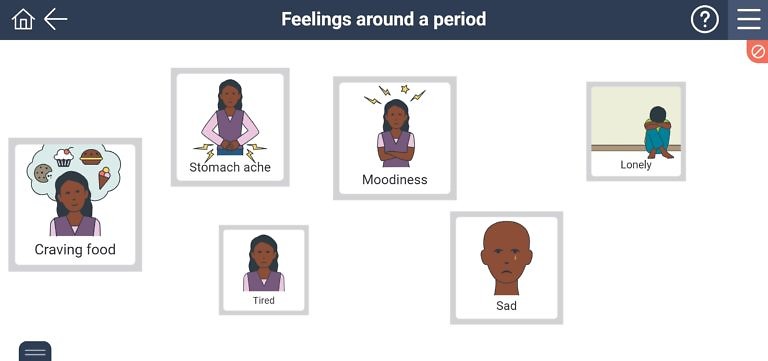Feelings around a period
You can save a PDF of this lesson by printing this page and clicking “Save to PDF”
This lesson supports curriculum codes:
- ABLEWA Stage C (VCHPEP030)
- ABLEWA Stage D (VCHPEP044; VCHPEP047; VCHPEP048)
- Year 5 (ACPPS052)
- Year 6 (ACPPS052)
Overview
This lesson aims to develop awareness and understanding of mood and behavioural changes that may occur as part of the menstrual cycle. Self-awareness of changes gives an opportunity to develop strategies for managing shifts in mood and behaviour.
Foundation Knowledge for this lesson includes differentiation of male and female bodies; awareness of age and body differences between babies, children, adolescents, and adults; receptive identification of vagina; public and private body parts; receptive identification of sanitary pads, bin, toilet, and underpants; receptive identification of blood.

Generalisation ideas:
- Personalising the lesson: Ensuring that an appropriate adult talks through this lesson, your student could be supported to identify premenstrual symptoms they experience.
- Normalising: Talking with older women familiar to your student about their own experiences with premenstrual symptoms to normalise the experience.
- Consequences: If these signs are present but menstruation hasn’t yet begun you can prepare your student with a menstrual kit to take in bag to manage when it begins.
- Developing strategies: Use symptom tracking to develop appropriate strategies for managing premenstrual symptoms e.g. taking time out, going to bed earlier, being kind to yourself.
- Identifying appropriate people to talk to if premenstrual symptoms are difficult to manage.
- Watching a DVD or YouTube clip that explains the process in more depth.
- Introducing a calendar: Introduce a calendar to show the menstrual cycle occuring once a month, add in the symptoms experienced each day leading up to a period. Notice patterns building up e.g. crave chocolate and period occurs two days later. There are a number of cycle tracker apps available online.
